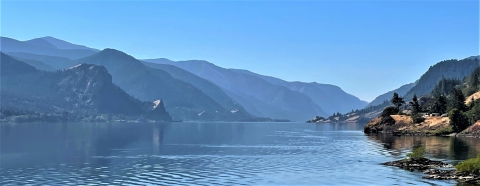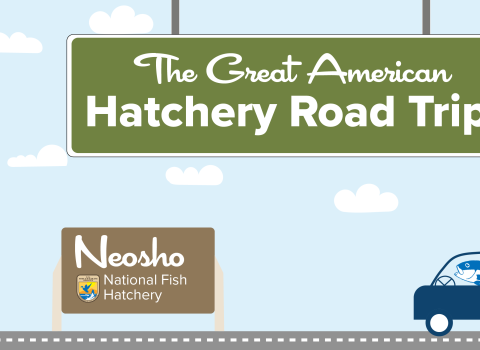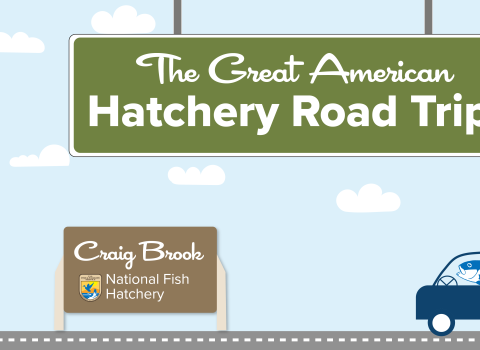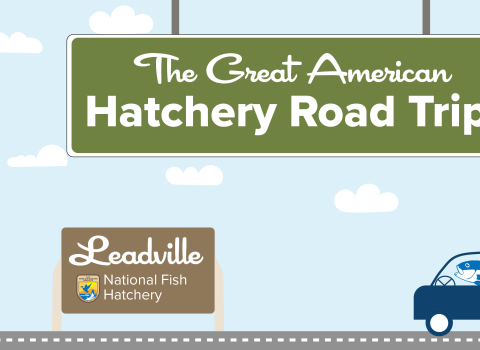View other hatcheries in the pacific northwest series!
Picture this: You're driving down the interstate, cruise control on, windows down, stereo blasting. It's a perfect 80 degrees, you don't have to work, and you've got the whole day ahead of you. You pull off the road and a beautiful vista lies in front of you. A pond sparkles in the sunshine, birds are chirping happily in the trees, and best of all...it's peaceful. You pop the trunk and pull out a fishing pole, that set of watercolors you've been meaning to use, your best pair of broken-in hiking boots, and breathe in the fresh summer air. But wait, where the heck are you?
Is it a national park? If we were going on overall vibes, the answer might be yes.
Is it a national wildlife refuge national wildlife refuge
A national wildlife refuge is typically a contiguous area of land and water managed by the U.S. Fish and Wildlife Service for the conservation and, where appropriate, restoration of fish, wildlife and plant resources and their habitats for the benefit of present and future generations of Americans.
Learn more about national wildlife refuge ? Getting warmer, but think more fins.
Is it one of the nation's most underrated outdoor destinations...national fish hatcheries? Ding ding ding! We have a winner!
The National Fish Hatchery System has been improving recreational fishing and restoring aquatic species since 1872 (uhhhh, yeah that makes them 150 years old!) and yet, lots of folks might not even know that their grounds are often open to the public and entry is FREE! The wonderful thing about fish hatcheries is that they offer something for everyone in your group...no more disgruntled sighs from the backseat!
Each hatchery highlighted in our road trip series is over 100 years old and has four sections of information:
🚙 Trip Highlights: This is where you'll find hatchery activity suggestions for different folks in your group. These aren't full lists, just some of the things we think are pretty cool. Before you hit the road, be sure to check each hatchery's web page for additional activities and we recommend calling ahead to check on their opening status and any possible closures. We've also got some good info on how and where to purchase a fishing license, if that's on your activity itinerary!
🚧 Detour: Is it really a road trip if you only go to one place? Well, yeah, but where's the fun in that? We've provided each hatchery with a nearby pit stop suggestion for the free spirits among us. (Full disclosure, besties: We haven't actually been to any of these spots and are in no way promoting them over other destinations, they just sound fun. Please do your research beforehand to check on fees, accessibility, travel restrictions, etc!)
🎶 Featured Song: One of the best parts of a road trip is the playlist. You probably have your own set of cool tunes, but we couldn't resist including some other suggestions for your listening pleasure!
🧭 Road Map: Ok, it's not actually a real map, but it's a fun, colorful graphic you can share online or print out for your trip!
Buckle those seatbelts, we’re taking you on a ride through some of the nation’s oldest hatcheries that you’ll definitely want to add to your summer road trip itineraries and they are free to the public.
Spring Creek National Fish Hatchery - Washington
Established in 1901, Spring Creek National Fish Hatchery annually raises 12.5 million Tule Fall Chinook salmon to fulfill Tribal Trust responsibilities and support the commercial fishing industry. The hatchery is funded by the U.S. Army Corp of Engineers and part of the Columbia River Gorge National Fish Hatchery Complex. Pro tip: The best time to visit the hatchery is late-August through September when the adult salmon are returning!
🚙 Trip Highlights
| There are plenty of opportunities to view fish, especially in the fall when the salmon return! However, if you’d rather catch fish than watch them, the shore areas provide respectable smallmouth bass habitat! Pro tip: if you want to see fish, it’s best to avoid visiting the hatchery in the summer, since all of the fish have migrated to the ocean! | |
| A great time to visit is the annual Open House held in September. Folks get the chance to view adult salmon, watch spawning, see adult salmon jumping up the fish ladder, and learn the important role hatcheries play. | |
| Wanna see something super cool? Every September, adult salmon return to the hatchery and enter by climbing up a ladder…a fish ladder, that is! Fish ladders are more like a staircase than a ladder and provide a resting space between “rungs” for the salmon making this journey. | |
| Interesting tidbit for history lovers: the original hatchery was flooded when the Bonneville Dam was completed in 1938. Plan a detour to the Dam to learn more about it! | |
| Wander down the hatchery’s nature trail to get closer to the river with spectacular views of the mountain and river recreationists; displaying their brightly colored sails. Bring along your favorite notebook and take a stab at penning some catchy haikus! |
🚧 Detour
We hope you’re not sick of fish because the detour for this trip just so happens to be another hatchery! A mere 10 minutes down the road is Little White Salmon National Fish Hatchery so you can keep the fishy times rolling! If you want to switch out salmon for sturgeon, head across the border to the state of Oregon’s Bonneville Hatchery and visit Herman the Sturgeon, a 15-foot cutie!
🎶 Featured Song
Get those toes tapping when you jam out to Ray Charles and his classic “Hit the Road Jack” (but please DO come back!).
🧭 Road Map
Before you take off on your most excellent journey to Spring Creek National Fish Hatchery, please call ahead for visitor hours and check out their website for even more to do during your visit. You can also download a high resolution PDF of the map!













